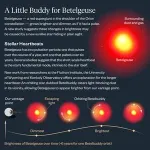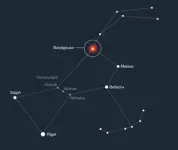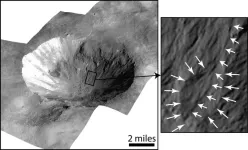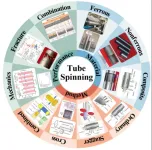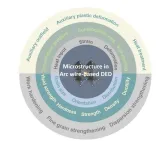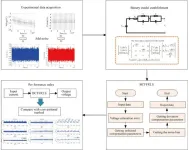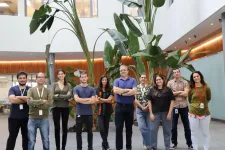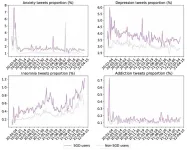(Press-News.org) The 10th-brightest star in the night sky, Betelgeuse, may not be on the brink of exploding as a supernova, according to a new study of the star’s brightening and dimming. Instead, recent research shows that the observed pulsing of the starlight is probably caused by an unseen companion star orbiting Betelgeuse.
Formally named Alpha Ori B, the “Betelbuddy” (as astrophysicist Jared Goldberg calls it) acts like a snowplow as it orbits Betelgeuse, pushing light-blocking dust out of the way and temporarily making Betelgeuse seem brighter. Goldberg and his colleagues present their simulations of this process in a paper accepted for publication in The Astrophysical Journal.
“We ruled out every intrinsic source of variability that we could think of as to why the brightening and dimming was happening in this way,” says Goldberg, the study’s lead author and a Flatiron research fellow at the Flatiron Institute’s Center for Computational Astrophysics. “The only hypothesis that seemed to fit is that Betelgeuse has a companion.”
Goldberg co-authored the study with Meridith Joyce of the University of Wyoming and László Molnár of Konkoly Observatory at the HUN-REN Research Centre for Astronomy and Earth Sciences in Hungary.
Uncovering the ‘Betelbuddy’
Betelgeuse is a red giant star around 100,000 times the brightness of our sun and more than 400 million times the volume. The star is nearing the end of its life span, and when it dies, the resulting explosion will be bright enough to see during the day for weeks.
Astronomers can predict when Betelgeuse will die by effectively ‘checking its pulse.’ It’s a variable star, meaning it gets brighter and dimmer, pulsing like a heartbeat. In Betelgeuse’s case, there are two heartbeats: one that pulses on a timescale a little longer than a year, and one that pulses on a timescale of about six years.
One of these heartbeats is Betelgeuse’s fundamental mode, a pattern of brightening and dimming that’s intrinsic to the star itself. If the star’s fundamental mode is its long-scale heartbeat, then Betelgeuse could be ready to blow sooner than expected. However, if its fundamental mode is its short-scale heartbeat, as several studies suggest, then its longer heartbeat is a phenomenon called a long secondary period. In that case, this longer brightening and dimming would be caused by something external to the star.
Scientists still don’t know for sure what causes long secondary periods, but one leading theory is that they arise when a star has a companion that circles it and barrels through the cosmic dust that is produced and expelled by the star. The displaced dust alters how much starlight reaches Earth, changing the star’s apparent brightness.
The researchers explored whether other processes may have caused the long secondary period, such as the churning of the star’s interior or periodic changes in the star’s powerful magnetic field. After combining data from direct observations of Betelgeuse with advanced computer models that simulate the star’s activity, the team concluded that the Betelbuddy is by far the most likely explanation.
“Nothing else added up,” Goldberg says. “Basically, if there’s no Betelbuddy, then that means there’s something way weirder going on — something impossible to explain with current physics.”
The team has yet to determine exactly what the Betelbuddy is, but they assume it’s a star of up to twice the sun’s mass.
“It is difficult to say what the companion actually is beyond providing mass and orbital constraints,” says Joyce. “A sunlike star is the most probable type of companion, but that is by no means conclusive.”
“A more exotic hypothesis I personally like, though the opinions of my co-authors may differ, is that the companion is a neutron star — the core of a star that has already gone supernova,” she says. “However, in that case, we would expect to see evidence of this with X-ray observations, and we haven’t. I think we should look again.”
A New View of an Old Star
Next, the team will play paparazzi, trying to snap images of the Betelbuddy with telescopes, as there will be a potential window of visibility around December 6.
“We need to confirm that Betelbuddy actually exists, since our result is based on inference, not on direct detection,” says Molnár. “So we’re working on observation proposals now.”
The researchers note that this study was only possible through team science.
“Without each of us considering this problem from very different angles — László as an expert in space-based observations and data analysis, Jared as someone who studies and simulates massive stars, and myself as a 1D modeler — the work wouldn’t have been possible,” says Joyce. “I want to thank the Flatiron Center for Computational Astrophysics in particular for creating an environment in which pulling together such a diverse range of scientists is possible.”
The team is also excited to have new information about a long-studied celestial body.
Betelgeuse “has been the target of countless studies since the dawn of modern astrophysics,” says Molnár. “And yet there’s still room to make significant new discoveries: in this case, a sunlike star hiding in plain sight, in the immense glare of a red supergiant. That is what excites me the most.”
ABOUT THE FLATIRON INSTITUTE
The Flatiron Institute is the research division of the Simons Foundation. The institute's mission is to advance scientific research through computational methods, including data analysis, theory, modeling and simulation. The institute's Center for Computational Astrophysics creates new computational frameworks that allow scientists to analyze big astronomical datasets and to understand complex, multi-scale physics in a cosmological context.
END
Betelgeuse Betelgeuse? Bright star Betelgeuse likely has a ‘Betelbuddy’ stellar companion
Betelgeuse's brightening and dimming over the years convinced some that it could be close to becoming a supernova. However, a new study suggests that these unexplained changes are due to a companion star that plows light-blocking dust out of its way.
2024-10-21
ELSE PRESS RELEASES FROM THIS DATE:
SwRI and JPL co-led study offers insights into mysterious features on airless worlds
2024-10-21
SAN ANTONIO — October 21, 2024—A Southwest Research Institute researcher collaborated with a team at NASA’s Jet Propulsion Laboratory to attempt to explain the presence of mysterious flow features that exist on the surfaces of airless celestial bodies, such as the asteroids Vesta and Ceres, explored recently by the NASA Dawn mission, or Jupiter’s moon Europa, which will soon be explored in detail by the NASA Europa Clipper mission that includes SwRI’s involvement.
In a new paper published in The Planetary Science Journal, its lead author, SwRI’s Dr. Michael J. Poston, and a team of researchers outline how post-impact conditions, ...
Artificial ‘nose’ can sniff out damaged fruit and spoiled meat
2024-10-21
Although smell has historically played an important role in the fight against diseases such as the plague and tuberculosis, the human nose is generally not sensitive enough to be used as a reliable diagnostic tool.
However, a new artificial ‘nose’ inspired by our sense of smell could now make it possible to detect undiagnosed disease, hazardous gases, and food that is starting to spoil.
And it is all made possible with technology that already exists.
Surrounded by antennas
What do your mobile phone, computer and TV have in common? Antennas.
“We are literally surrounded by technology that communicates using antenna technology,” said Michael ...
Tube spinning process: Recent advances and challenges
2024-10-21
Amidst the sustainable evolution of the economy and society, the issues of energy scarcity and environmental degradation have gained increasing prominence, making energy conservation and emission reduction the focal point of societal concern. Within this context, metal tubes fittings, as essential components, wield significant and extensive influence in domains such as aviation, aerospace, and new energy vehicles. Notably, the burgeoning prominence of advanced plastic forming methods, epitomized by the flexible medium forming process of tubes, has garnered ...
Enhancement of material microstructure and properties in Arc wire-based direct energy deposition: A short review
2024-10-21
In recent years, additive manufacturing technology has attracted considerable attention from various stakeholders. Among the different techniques, Arc wire-based direct energy deposition (DED) has experienced a notable increase in development, offering compelling advantages such as cost-effectiveness and high forming efficiency. However, a high deposition rate results in extremely high heat input and temperature inhomogeneity, leading to a deterioration in surface quality, a reduction in material properties, an increase in residual stresses and even distortion and cracking. Consequently, the current research agenda is focused on developing methods to ensure the quality ...
Cloud computing captures chemistry code
2024-10-21
RICHLAND, Wash.—Some computing challenges are so big that it’s necessary to go all in. That’s the approach a diverse team of scientists and computing experts led by the Department of Energy’s Pacific Northwest National Laboratory, along with colleagues from Microsoft and other national laboratories and universities, are taking to democratize access to emerging cloud computing resources.
The effort, outlined in a recent peer-reviewed journal publication, provides a road map to moving scientific computing resources into a sustainable ecosystem that evolves as ...
Novel electrothermal model enables co-estimation of SOC and SOT
2024-10-21
For the main energy storage system for EVs, Li-ion batteries are extensively applied owing to their excellent overall performance The safe and efficient operation of the electric vehicle significantly depends on the accurate state-of-charge (SOC) and state-of-temperature (SOT) of Lithium-ion (Li-ion) batteries. A recent breakthrough study presented by researchers from the Tongji University and Chongqing University introduces a co-estimation of state-of-charge and state-of-temperature for large-format lithium-ion batteries based on ...
Advanced online method for battery model parameter identification: Bias-compensated forgetting factor recursive least squares
2024-10-21
Lithium-ion power battery technology stands out as a pivotal component in advancement of new energy electric vehicles (EVs). Battery parameter identification, as one of the core technologies to achieve an efficient battery management system (BMS), is the key to predicting and managing the performance of Li-ion batteries. A recent breakthrough study presented by researchers from Hebei University of Technology proposes an online battery model parameters identification approach based on bias-compensated forgetting factor recursive least squares. This advanced method is expected to improve the accuracy of parameter identification under different noise.
The ...
Understanding the maturation of white blood cells to find new therapies against lymphoblastic leukaemia
2024-10-21
Over four hundred people, 80% of them being children under 14 years old, will be diagnosed with B-cell Acute Lymphoblastic Leukaemia (B-ALL) next year in Spain, according to the latest projections from the Spanish network of cancer registries (REDECAN). Survival rates for this rapid-growing and aggressive type of blood cancer are high in youth, but fall rapidly with age, especially after 40, stressing the need for new therapeutic alternatives.
B-ALL arises when B-lymphocytes - the antibody producing cells of the immune system - fail to properly mature in the bone marrow, leading to the accumulation of immature progenitors ...
Sexual and gender-diverse individuals face more health challenges during COVID-19: Insights from a large-scale social media analysis
2024-10-21
A new study by researchers at Zhejiang University has highlighted the disproportionate health challenges faced by sexual and gender-diverse (SGD) individuals during the COVID-19 pandemic. By analyzing over 471 million tweets using advanced natural language processing (NLP) techniques, the study reveals that SGD individuals were more likely to discuss concerns related to social connections, mask-wearing, and experienced higher rates of COVID-19 symptoms and mental health issues than non-SGD individuals. The study has been published in the journal Health Data ...
First ever Hispanic thrifty food plan published
2024-10-21
A new study1 has unveiled the Hispanic Thrifty Food Plan (H-TFP), a culturally adapted and affordable diet specifically designed to align with the eating habits of U.S. Hispanic households. The research, led by Adam Drewnowski, PhD, from the University of Washington, used advanced dietary modeling to create a version of the USDA’s Thrifty Food Plan (TFP) that respects the distinctive food patterns of Hispanic communities.
The USDA's Thrifty Food Plan is the foundation for setting benefits under the Supplemental Nutrition Assistance Program (SNAP), but it has not traditionally accounted for the ...
LAST 30 PRESS RELEASES:
Geometry shapes life
A CRISPR screen reveals many previously unrecognized genes required for brain development and a new neurodevelopmental disorder
Hot flush treatment has anti-breast cancer activity, study finds
Securing AI systems against growing cybersecurity threats
Longest observation of an active solar region
Why nail-biting, procrastination and other self-sabotaging behaviors are rooted in survival instincts
Regional variations in mechanical properties of porcine leptomeninges
Artificial empathy in therapy and healthcare: advancements in interpersonal interaction technologies
Why some brains switch gears more efficiently than others
UVA’s Jundong Li wins ICDM’S 2025 Tao Li Award for data mining, machine learning
UVA’s low-power, high-performance computer power player Mircea Stan earns National Academy of Inventors fellowship
Not playing by the rules: USU researcher explores filamentous algae dynamics in rivers
Do our body clocks influence our risk of dementia?
Anthropologists offer new evidence of bipedalism in long-debated fossil discovery
Safer receipt paper from wood
Dosage-sensitive genes suggest no whole-genome duplications in ancestral angiosperm
First ancient human herpesvirus genomes document their deep history with humans
Why Some Bacteria Survive Antibiotics and How to Stop Them - New study reveals that bacteria can survive antibiotic treatment through two fundamentally different “shutdown modes”
UCLA study links scar healing to dangerous placenta condition
CHANGE-seq-BE finds off-target changes in the genome from base editors
The Journal of Nuclear Medicine Ahead-of-Print Tip Sheet: January 2, 2026
Delayed or absent first dose of measles, mumps, and rubella vaccination
Trends in US preterm birth rates by household income and race and ethnicity
Study identifies potential biomarker linked to progression and brain inflammation in multiple sclerosis
Many mothers in Norway do not show up for postnatal check-ups
Researchers want to find out why quick clay is so unstable
Superradiant spins show teamwork at the quantum scale
Cleveland Clinic Research links tumor bacteria to immunotherapy resistance in head and neck cancer
First Editorial of 2026: Resisting AI slop
Joint ground- and space-based observations reveal Saturn-mass rogue planet
[Press-News.org] Betelgeuse Betelgeuse? Bright star Betelgeuse likely has a ‘Betelbuddy’ stellar companionBetelgeuse's brightening and dimming over the years convinced some that it could be close to becoming a supernova. However, a new study suggests that these unexplained changes are due to a companion star that plows light-blocking dust out of its way.

